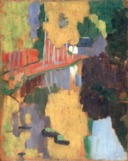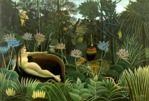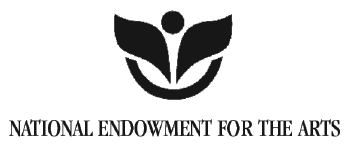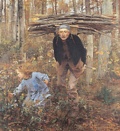N.A. - Member of the American honorary association of artists, the National Academy, or National Academy of Design. A.N.A. indicates an associate member.
NAAO - See National Association of Artists' Organizations.
Nabis - An avant-garde group of French painters and poets, active 1888-99, who were persuaded by the advice Paul Gauguin (French, 1848-1903) gave Paul Serusier (French, 1863-1927) in 1888 at Pont-Aven to reject naturalistic representation, and instead, paint in flat areas of pure color. Also influenced by Odilon Redon (French, 1840-1916) and other members of the Symbolist movement, the Nabis felt that a painting should not imitate reality but parallel nature, creating a world unto itself. They stressed the imortance of subjective and sometimes mystical perceptions. Along with painting, they worked in theater design, book illustration, posters and stained glass, and were to various extents, indebted to contemporary Japanese prints. Piérre Bonnard (French, 1867-1947) and Edouard Vuillard (French, 1868-1940) were probably the best painters of the group and eventually reverted to a modified style known as Intimisme. Other members included Aristide Maillol (French, 1861-1944), Maurice Denis (French, 1870-1943), Paul Ranson (French, 1864-1909), Ker-Xavier Roussel (French, 1867-1944), Félix Vallatton (French, 1865-1925), Henri-Gabriel Ibels (French, 1867-1936), Jozsef Rippl-Ronai (French, 1867-1944), and Sérusier.
It was Sérusier who suggested the name Nabis, from the Hebrew word Nebiim, meaning "prophets."
(pr. NAH-bee)
Examples:

Paul Sérusier (French, 1863-1927),
The Talisman,
1888, oil on wood
panel (cigar box lid), 10 3/4 x 8
1/2 inches (27 x 21.5 cm), Musée d'Orsay, Paris. This
painting is generally considered the first Nabis work.

Paul Sérusier (French, 1863-1927),
Roof Tops in Paris, c. 1891, oil
on canvas, 15 x 18 inches
(38.0 x 45.5 cm), Tate Gallery, London.
Pierre Bonnard (French, 1867-1947), Before Dinner, 1924, oil on canvas, 35 1/2 x 42 inches (90.2 x 106.7 cm), Metropolitan Museum of Art, NY.

Pierre Bonnard, The Red Blouse, 1925, oil
on canvas, 50 x 52 cm, Georges
Pompidou Center, Paris.

Edouard Vuillard (French, 1868-1940), Les coulisses du Théâtre de l'Oeuvre,
about 1894, oil on wood
panel, 18 3/4 x 17 3/4 inches, Minneapolis
Institute of Arts.

Maurice Denis (French, 1870-1943), July,
1892, oil on canvas,
30 x 60 cm, Fondation Rau pour le Tiers-Monde, Zurich.
![]()
Maurice Denis, Orpheus and Eurydice, 1910, oil
on canvas, 45 1/4 x 65 inches,
Minneapolis Institute of Arts.
Red Grooms (American, 1937-), Nabis, 1998, oil on wood, 44 1/4 x 88 1/4 inches, Kemper Museum of Contemporary Art, Kansas City, MO. Pictured here, from left to right are Ker-Xavier Roussel, Édouard Vuillard, Romain Coolus, and Félix Vallatton. Coolus was a writer. Grooms's portrait was inspired by an 1899 photograph taken in Paris.
Quote:
NAEA - See National Art Education Association (NAEA).
naif, naïf - See naive art.
naive art or naïve art - The style of naive painting is characterized by a careful, simplifying approach, non-scientific perspective, bright colors, and often, an enchantingly literal depiction of imaginary scenes. Although not following any particular movement or aesthetic, naive painters have been a continuing international phenomenon and influence since the beginning ot the twentieth century. The term usually refers to works produced by artists (also called naifs or naïfs) who had no formal training. Some trained artists, however, have deliberately affected a naive style. Among the artists whose work may be called naive, Henri Rousseau (French, 1844-1910) is the most famous. His nickname, "Le Douanier," refers to his employment as a toll-collector when he took up painting as a spare-time occupation. Rousseau's simplicity and naivety were notorious, his paintings childlike, non-naturalistic, and brightly colored. His pictures are appealing in their directness and depth, and in some ways are very sophisticated, their design and colors worked out in great detail. Their apparent affinity with non-Western art and their bold expressive qualities made them appealing to the early modernists searching for new forms of expression.
(pr. nahy-EEV)
Examples:

Henri Rousseau (born Henri-Julien-Félix
Rousseau, called "le Douanier") (French, 1844-1910),
The Repast of the Lion, c. 1907, oil on canvas,
44 3/4 x 63 inches (113.7 x 160 cm), Metropolitan Museum of Art,
NY. (On the Met's page, you can enlarge any detail.)

Henri Rousseau, The Dream, 1910, oil
on canvas, 6 feet 8 1/2 inches
x 9 feet 9 1/2 inches (204.5 x 298.5 cm), Museum of Modern Art,
New York.

Henri Rousseau, The Banks of the Bièvre near Bicêtre,
oil on canvas,
21 1/2 x 18 inches (54.6 x 45.7 cm), Metropolitan Museum of Art,
NY.
The art of naive artists is sometimes referred to as primitive, but is now most commonly called outsider art and folk art.
Also see Aboriginal art, kitsch, obsession, and paint-by-number.
namban - In Japanese art, a picture of foreigners.
naming stage - Of Victor Lowenfeld's Stages of Artistic Development, naming is the fourth and final sub-stage of the first stage, the scribble stage. The Scribble stage typically occurs at 2-4 years old. At the Naming substage the child tells stories about the scribble. There is a change from a kinesthetic thinking in terms of motion to imaginative thinking in terms of pictures. This is one of the great occasions in the life of a human. It is the development of the ability to visualize in pictures. Also see preschematic stage (4-6 years old), schematic stage (6-9), dawning realism stage (9-11), and the pseudorealistic stage (11-13), and title.
Related link:
naos - See cella.
naphthalene
- A toxic, crystalline material used as a fumigant
for moths and larvae.
Also see art conservation.
Naples yellow - A particular yellow pigment.
Related resource:
Also see antimony.
Nara - A period in Japanese art history from 710-794. The Nara period was preceded by the Hakuho period (sometimes called the Early Nara period) from 645-710, and followed by the Heian period from 794-1185.
Examples:

Japan, Nara Period, 8th century, Jar with cover, three-color glaze,
excavated at Taishokukanyama,
Ibaragi-shi, Osaka, height
15.6 cm, Tokyo National Museum. Japanese authorities have designated
this piece an "Important Cultural Property."

Attributed to Emperor Shomu (Japan), Nara
Period, 8th century, Kengu-kyo Sutra, a Buddhist scripture
also known as "Ojomu", brushed
ink calligraphy
on paper, 27.5 x 696.9 cm, Tokyo National
Museum. Japanese authorities have designated this a "National
Treasure." See Buddhist
art.

Japan, Nara Period, 8th century, Bowl with cover having yasti-shaped handle,
sahari (a copper alloy),
mouth diameter 6.5, overall
height 9.3 cm, Tokyo National
Museum. Japanese authorities have designated this piece of the
Horyuji Treasure an "Important Cultural Property."
See yasti.
narthex - In architecture, a porch or vestibule of a church, generally colonnaded or arcaded and preceding the nave.
nashiji - In Japanese art tradition, the pearskin effect in oriental lacquerware, created by sunken scattered metal filings.
National Art Education Association (NAEA) - A non-profit educational organization, whose members include nearly 15,000 art educators from every level of instruction: early childhood, elementary, intermediate, secondary, college and university, administration, museum education, lifelong learning . . . also publishers, manufacturers and suppliers of art materials, parents, students, retired teachers, arts councils, schools . . . anyone and everyone concerned about quality art education in our schools. Its mission is to promote art education through professional development, service, advancement of knowledge, and leadership. The NAEA was founded in 1947 with the merger of the Western, Pacific, Southeastern, and Eastern Region Art Associations, plus the art department of the National Education Association (NEA), and now has branches in fifty states plus the District of Columbia, U.S. Possessions, most Canadian Provinces, U.S. military bases around the world, and twenty-five foreign countries. 1916 Association Drive, Reston, VA 22091-1590. Telephone 703.860.8000. Also see the NAEA's Electronic Media Special Interest Group (EMIG) site on the Web.
Also see United States Society for Education Through Art (USSEA).

National Association of Artists' Organizations (NAAO) - An association of art organizations from every discipline, established in order to present a unified national voice. Their site provides information on the NAAO national conference, NAAO publications, and advocacy, along with details on membership.
Also see artists' organizations.
![]() National
Association of Independent Artists (NAIA) - An American organization whose goal
is "to enhance the economic well-being of people who exhibit
their work at high quality art and craft shows, encourage creative
expression and artistic excellence, and expand public awareness,
appreciation and acquisition of fine art and fine craft."
The NAIA was formed in Chicago in 1995.
National
Association of Independent Artists (NAIA) - An American organization whose goal
is "to enhance the economic well-being of people who exhibit
their work at high quality art and craft shows, encourage creative
expression and artistic excellence, and expand public awareness,
appreciation and acquisition of fine art and fine craft."
The NAIA was formed in Chicago in 1995.
Also see artists' organizations.
 National
Education Association (NEA)
- America's oldest and largest organization committed to advancing
the cause of public education. Founded in 1857 in Philadelphia
and now headquartered in Washington, D.C., the NEA has over 2.2
million members who work at every level of education, from pre-school
to university graduate programs. NEA [not to be confused with
the National Endowment for the Arts]
has affiliates in every state as well as in over 13,000 local
communities across the United States. Anyone who works for a public
school district, a college or university, or any other public
institution devoted primarily to education is eligible to join
NEA. There are special membership categories for retired educators
and college students studying to become teachers. NEA members
nationwide set Association policy, most notably through an annual
Representative Assembly held every July. NEA members at the state
and local level elect the more than 9,000 RA delegates, who, in
turn, elect NEA's top officers, debate issues, and set NEA policy.
NEA is a volunteer-based organization supported by a network of
staff at the local, state, and national level. At the local level,
NEA affiliates are active in a wide variety of activities, everything
from conducting professional workshops on discipline and other
issues that affect faculty and school support staff to bargaining
contracts for school district employees. At the state level, NEA
affiliate activities are equally wide-ranging. NEA state affiliates,
for instance, regularly lobby legislators for the resources schools
need, campaign for higher professional standards for the teaching
profession, and file legal actions to protect academic freedom.
At the national level, NEA's work ranges from coordinating innovative
projects to restructure how learning takes place to fighting congressional
attempts to privatize public education.
National
Education Association (NEA)
- America's oldest and largest organization committed to advancing
the cause of public education. Founded in 1857 in Philadelphia
and now headquartered in Washington, D.C., the NEA has over 2.2
million members who work at every level of education, from pre-school
to university graduate programs. NEA [not to be confused with
the National Endowment for the Arts]
has affiliates in every state as well as in over 13,000 local
communities across the United States. Anyone who works for a public
school district, a college or university, or any other public
institution devoted primarily to education is eligible to join
NEA. There are special membership categories for retired educators
and college students studying to become teachers. NEA members
nationwide set Association policy, most notably through an annual
Representative Assembly held every July. NEA members at the state
and local level elect the more than 9,000 RA delegates, who, in
turn, elect NEA's top officers, debate issues, and set NEA policy.
NEA is a volunteer-based organization supported by a network of
staff at the local, state, and national level. At the local level,
NEA affiliates are active in a wide variety of activities, everything
from conducting professional workshops on discipline and other
issues that affect faculty and school support staff to bargaining
contracts for school district employees. At the state level, NEA
affiliate activities are equally wide-ranging. NEA state affiliates,
for instance, regularly lobby legislators for the resources schools
need, campaign for higher professional standards for the teaching
profession, and file legal actions to protect academic freedom.
At the national level, NEA's work ranges from coordinating innovative
projects to restructure how learning takes place to fighting congressional
attempts to privatize public education.
Also see American Federation of Teachers (AFT), a union with which the NEA may merge in 1998.

National Endowment for the Arts (NEA) - The federal grantmaking agency that the US Congress created to foster the excellence, diversity and vitality of the visual, literary, design, and performing arts, to benefit all Americans. It does its work by awarding grants to nonprofit arts organizations in all fields as well as through its own leadership activities. As mandated by statute, the NEA [not to be confused with the National Education Association] promotes the continued vitality and excellence of the arts throughout the United States. It augments access to and appreciation of all the arts. It endeavors to support arts activities of merit, to promote the overall financial stability of arts organizations, and to make the arts available to all Americans. The Arts Endowment seeks to increase non-Federal contributions to cultural activity through both its funding and advocacy. The agency does not direct the creative activities of individual artists or arts organizations. Rather, it acts as a catalyst and as partner with others who support the arts. Although a very small percentage of the grants made by the Endowment have stirred controversy, some of it very negative, it continues to endeavor to preserve and improve the environment in which the arts have flourished, never imposing a single aesthetic standard or attempting to direct artistic content.
Also see censorship, First Amendment rights, New Deal art, xenophilia, and xenophobia.
 National Endowment
for the Humanities (NEH) -
The NEH is an independent agency of the United States Government
that makes grants for projects in history, languages, philosophy,
and other areas of the humanities.
The act that established the NEH says "The term 'humanities'
includes, but is not limited to, the study of the following: language,
both modern and classical;
linguistics; literature; history; jurisprudence philosophy; archaeology;
comparative religion; ethics; the history, criticism and theory
of the arts; those aspects of social sciences which have humanistic
content and employ humanistic
methods; and the study and application of the humanities to the
human environment with particular attention to reflecting our
diverse heritage, traditions, and history and to the relevance
of the humanities to the current conditions of national life."
The NEH provides grants to individuals and institutions for projects
in the humanities. Grants support research in the humanities,
educational opportunities, the research and writing of scholarly
texts, translations of important works
in the humanities, preservation of texts and materials important
to the humanities, museum exhibitions, television and radio programs,
and public programs that offer examination of ideas and themes
in the humanities.
National Endowment
for the Humanities (NEH) -
The NEH is an independent agency of the United States Government
that makes grants for projects in history, languages, philosophy,
and other areas of the humanities.
The act that established the NEH says "The term 'humanities'
includes, but is not limited to, the study of the following: language,
both modern and classical;
linguistics; literature; history; jurisprudence philosophy; archaeology;
comparative religion; ethics; the history, criticism and theory
of the arts; those aspects of social sciences which have humanistic
content and employ humanistic
methods; and the study and application of the humanities to the
human environment with particular attention to reflecting our
diverse heritage, traditions, and history and to the relevance
of the humanities to the current conditions of national life."
The NEH provides grants to individuals and institutions for projects
in the humanities. Grants support research in the humanities,
educational opportunities, the research and writing of scholarly
texts, translations of important works
in the humanities, preservation of texts and materials important
to the humanities, museum exhibitions, television and radio programs,
and public programs that offer examination of ideas and themes
in the humanities.
Also see humanism.
 National Society for Education in Art and Design (NSEAD) - The NSEAD is the leading national authority concerned with art, craft and design for all phases of education in the United Kingdom. With its organizational roots going back more than one hundred years, NSEAD is the UK's affiliate member of the International Society for Education Through Art (InSEA). NSEAD promotes and represents art and design in all phases of education throughout the UK. Its members include the include the majority of art and design educators in the UK, creating a vital, articulate, well-informed professional community. It provides an essential forum for the dissemination of ideas, practical developments and research findings in art and design education. It is the key provider of high quality in-service education, on-line and other information and publications for art and design education. NSEAD's site provides news, events, resources, links and research information.
National Society for Education in Art and Design (NSEAD) - The NSEAD is the leading national authority concerned with art, craft and design for all phases of education in the United Kingdom. With its organizational roots going back more than one hundred years, NSEAD is the UK's affiliate member of the International Society for Education Through Art (InSEA). NSEAD promotes and represents art and design in all phases of education throughout the UK. Its members include the include the majority of art and design educators in the UK, creating a vital, articulate, well-informed professional community. It provides an essential forum for the dissemination of ideas, practical developments and research findings in art and design education. It is the key provider of high quality in-service education, on-line and other information and publications for art and design education. NSEAD's site provides news, events, resources, links and research information.
Naturalism or naturalism - A style in which an artist intends to represent a subject as it appears in the natural world — precisely and objectivly — as opposed to being represented in a stylized or intellectually manipulated manner. Although naturalism is often used interchangeably with the term realism, there is a difference between them. The realism of Gustave Courbet (French, 1819-1877) is more interested in the honest depiction of unpretentious subjects, while the naturalism of Ernest Meissonier (French, 1815-1891) is more a visually accurate depiction of subjects which in other hands might well have been depicted pretentiously.
Examples of naturalism:
Bartolomé Esteban Murillo (Spanish, 1618-1682), The Young Beggar, c. 1650, oil on canvas, 1.34 x 1.00 m, Louvre.

Jules Bastien-Lepage (French, 1848-1884),
The Wood Gatherer, 1881, oil
on canvas, Milwaukee Art Museum,
WI. Emile Zola (1840-1902) described Bastien-Lepage's work as
"Impressionism corrected, sweetened and adapted to the taste
of the crowd." See Heidelberg
school and Impressionism.
Also see isms and -ism.

nave - In the architecture of a church, the major, central area where the congregation gathers. It leads from the main entrance to the altar and choir, and is usually flanked by side aisles.
Also see cathedral, clerestory, column, Gothic, labyrinth, Middle Ages, pier, trabeation, triforium, and vault.
https://inform.quest/_art